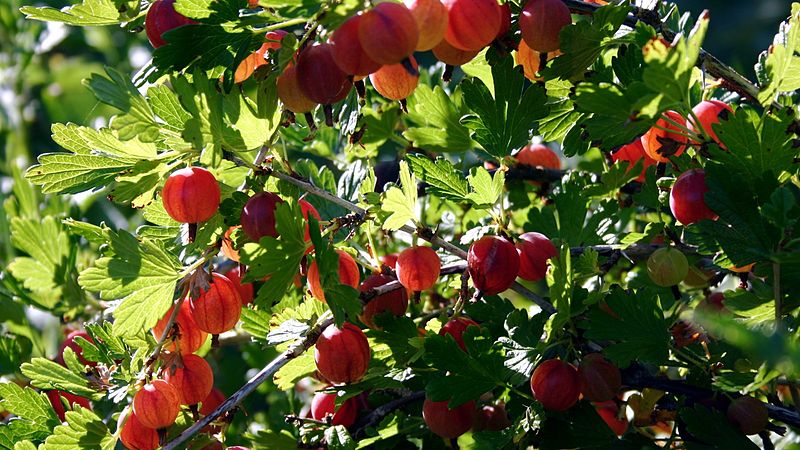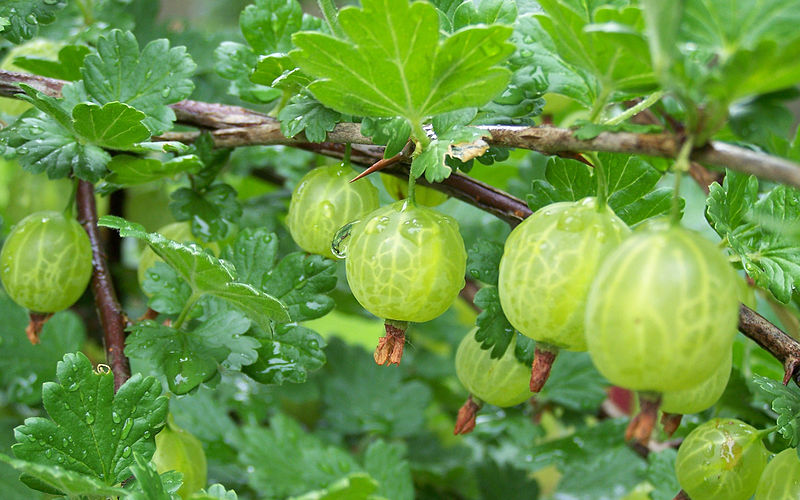
Gooseberry is another great fruit for the home garden. The genus Ribes is home to both gooseberries and currants, so these two plants are closely related. Both are hardy and productive. One way to distinguish gooseberry from currant, is the arrangement of fruits. Gooseberry produces single fruits, or small clusters of 2-3 berries, from leaf axils. Gooseberry fruits are roughly the size of a small grape or large pea. Currants produce 8-10 smaller fruits in a long cluster. Gooseberries also have a spine at each leaf node, while currants do not have thorns or spines.
 Site Cultivar Selection
Site Cultivar Selection
For the best fruit production, choose a full sun location, although gooseberries do tolerate some shade. They also are tolerant of many soil types, thriving in often less-then-perfect locations, including alkaline soil.
Cultivated varieties (cultivars) used for fruit production have fine, fibrous root systems and don't do their best on very dry sites. Plan to provide supplement irrigation and mulch for good fruit production.
Finally, gooseberries bloom in very early spring, so choose a location that warms up slowly to avoid flower damage from late season frost. A north exposure, or north-facing slope works well.
Gooseberry plants can be difficult to find locally, but can be ordered from companies such as Stark Bro's, or Krieger's Nursery. Plants are shipped in early spring, bare root. It's a good idea to prepare the planting site in fall, ready for April when the plants arrive. Remove any existing vegetation, including perennials weeds, and incorporate compost or aged manure for additional organic matter.
Gooseberries are self-fertile. However, larger fruits and greater production occur if more than one cultivar is used for cross-pollination. Both American and European gooseberry cultivars are available, but American types are usually more disease resistant, productive, and adaptable to a wider range of environmental conditions.
Good fruit producing gooseberry cultivars:
- 'Pixwell' – American cultivar, developed in North Dakota in 1932. Low, 3' bushes are hardy and productive. Medium-sized fruits start out green and ripen to purple.
- 'Hinnonmaki Red' and 'Hinnonmaki Yellow' - American cultivars, medium-sized red and green fruit.
- 'Captivator' - A cross of American and European cultivars, has red, tear-drop-shaped fruit. Nearly thornless and mildew-resistant.
- 'Invicta' – European cultivar. Considered by some to be the best gooseberry available in North America. Resistant to mildew, but susceptible to leaf spot. Very large fruit with bland flavor.
Planting and Maintenance
Plant gooseberries as early as possible in spring, as soon as the soil is workable. Even plants that are beginning to leaf out can tolerate temperatures as cold as 19°F and its important to give them as much time for root develop as possible before hot weather arrives. Handle the bare-root plants carefully, keeping the roots cool and moist.
Gooseberries should be planted at least 1 inch deeper than they were at the nursery. It's best if the lower canes are covered with soil, so that 2-3 buds are in the soil, to encourage development of a larger root system. After planting, pruning the stems back so that each has only 4-6 above ground buds; this encourages growth of additional stems from the crown. Mulch plants with 3-4 inches of organic mulch and keep the plants well watered during the establishment year.
Fertilize gooseberries in spring, before new growth starts, with ¼-1/2 lb. of fertilizer per plant, depending on the plant's vigor the previous season. Choose a balanced fertilizer, such as 10-10-10, and sprinkle it around each plant, lightly working it into the soil. Composted manure is also an excellent nutrient source in place of commercial fertilizers.
Regular pruning enhances plant vigor and increases fruit production by improving sun penetration and reducing disease problems. In the first three years, allow 4-5 new canes to develop each year and remove any weak or spindly canes. By the fourth summer begin removing the oldest stems each year, by cutting them down close to the plant's crown, in early spring before new growth starts. A well-developed mature plant should have 9-12 canes.
Gooseberries produce fruit on 1, 2 and 3 year old stems. A vigorous, mature plant should produce up to 4 quarts of fruit each year.
More information
Image
- Green gooseberry in summer. Image by Pixabay.com.